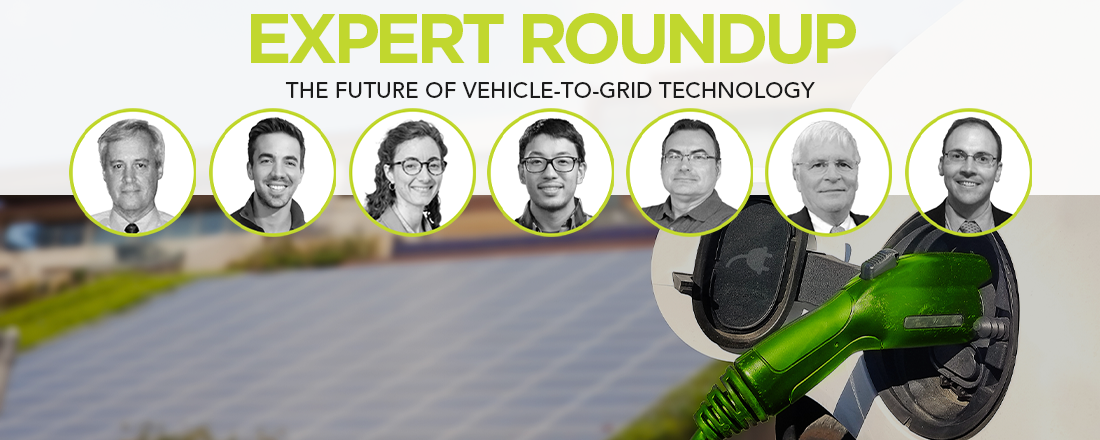Matching electricity supply and demand throughout the day is an essential consideration in the transition to 100% renewable energy. Leading clean energy sources such as solar and wind are intermittent energy sources, meaning that they produce different amounts of energy at various times of the day. Energy storage solutions allow energy to be stored during peak production times and discharged during peak electricity demand times. As we seek to maximize the use of renewables on the grid, Vehicle-to-Grid (V2G) technology is quickly emerging as a leading energy storage solution.
V2G utilizes the batteries that already exist in electric vehicles (EVs) to store the energy on our grid. Typically, we think of EV batteries in terms of one-directional charging. With V2G technology, electricity flows in two directions, the grid can charge the vehicle, and the vehicle can also send energy back into the grid. V2G technology allows us to optimize charging times to provide maximum benefit to the grid. For example, EVs can fully charge during the middle of the day, when solar panels are producing the most energy and electricity costs are low. Excess energy in the battery can be directed back into the grid during peak electricity demand hours in the evening.
V2G technology can help increase the use of renewables, create a more efficient grid, lower EV charging costs, and will naturally expand as more EVs hit the road. Several technology and policy advancements are needed before V2G technology can be deployed at scale.
To learn about the role of V2G technology as a grid stabilization tool and when it will be ready for scale, we called on seven V2G experts. Here’s what they had to say.
Terms to Know
V2G: Vehicle to Grid
Refers to bi-directional charging capabilities where the EV battery can both be charged by the grid and also discharge energy back into the grid.VGI: Vehicle Grid Integration
Broadly encompasses the ways that electric vehicles and the grid can interact including V2G technology and other ways to optimize vehicle and grid interactions such as providing incentives for charging during off-peak hours.- V2X: Vehicle to X
Vehicle to “anything” where the X refers to any of the use cases of bi-directional charging including vehicle-to-grid, vehicle-to-home or vehicle-to-vehicle.

Adam Langton
Connected eMobility and Energy Services Manager at BMW North America
“V2G vehicles could be an ideal response to high-demand conditions because they can be tactically deployed in the neighborhoods that are experiencing grid stress. Likewise, when the grid has excess renewable energy, V2G vehicles can charge up, helping the grid absorb that power without being overloaded. V2G can make the grid nimbler in responding to fluctuations in renewable energy supply, supporting California’s goal of 100% renewable energy.
Preparing for large-scale V2G deployment requires collaboration between grid stakeholders, the transportation sector, and EV drivers. Grid stakeholders need to provide the right incentives for drivers to purchase V2G-enabled vehicles and make their batteries available to use as a grid resource when needed. Using a V2G vehicle as a grid resource requires utility approval. Regulators must develop clear rules to ensure that V2G is used safely, while also making sure that the approval process is fast and easy to understand. To avoid investing in a vehicle that cannot be used at that facility, grid operators should consider a way for drivers to “pre-assess” their home or business as V2G-ready. Finally, to get large-scale participation, drivers must know that vehicle performance and range is not impacted and their mobility is not affected when they use their vehicle for grid services.”

Bjoern Christensen
Founder & Managing Director of Vehicle-Grid-Integration Advisory Company, Next-Dimension
“We are seeing two giant industries ⎯ electricity and automobile ⎯ meeting each other in what is known as vehicle grid integration (VGI). EVs are no longer disjunct from the grid but become a part of the grid when they are connected through a charging station. V2G technology allows an EV to export power from the battery to the grid. In California, 5 million EVs will be on the road in 2030. If these EVs were all V2G-capable, they would be able to provide enough storage to flatten the neck of the duck curve every day between 4 p.m. and 9 p.m. when there is a shortage of renewable energy.
V2G technology was invented in 1996 and is now gaining considerable momentum in the marketplace, with large original equipment manufacturers like Volkswagen and Renault launching V2G vehicles for their next model year. The main bottlenecks for wide penetration of V2G are regulations and standards. Standards are in place, and regulations are still catching up. It will take 2-3 years before we will see widespread deployment of V2G EVs.”

Aimee Gotway Bailey, PhD
Director of Innovation & Portfolio Management at National Grid Partners
“The increasing frequency and intensity of wildfires and rolling blackouts in California have accelerated the need to bolster resilience in our homes and work. V2X solutions can harness energy stored in EV batteries to provide critical backup power to households and businesses during power outages, in addition to providing power to stabilize the grid. V2X solutions will be critical tools for adapting to climate change and progressively extreme weather. Although still nascent, V2X solutions are rapidly arriving on the market. This year, Ford and Volkswagen are slated to join Nissan in offering vehicle models with V2X capabilities as a standard, making 2022 a bellwether, if not breakout, year for the industry.”

Jerry Jackson
President of Jackson Associates and publisher of MAISY Utility Databases
“The rapidly growing EV market provides enormous potential for V2G technology to support the electric grid. Discharging power from EV batteries to the grid during peak times will reduce stress on the electric grid, reduce emissions, and potentially avoid blackouts and rolling brownouts.
In 2019, we conducted a cost-benefit study by using utility customer data for Southern California Edison. The study showed that V2G could reduce peak electricity demand by about 20%. Rebates from utilities for avoided peak power costs would result in annual payments of $560 to each program participant. Furthermore, only about 10% of the utility’s customers would be required to participate in the program.
Unfortunately, V2G is still at the proof-of-concept, individual project stage. Before V2G is ready to scale, we must address EV battery warranty issues, electric utility regulatory issues, lack of required bidirectional hardware and charging protocols, and lack of data about potential battery degradation. Resolving these issues requires cooperation among automakers, electric utilities, regulators, and providers of ancillary supporting products such as control software. The current energy crisis and climate concerns will undoubtedly accelerate this cooperation, with some notable V2G applications appearing in several years.”

Alan Jenn
Assistant Director of Institute of Transportation Studies at the University of California, Davis
“V2G technology will be an increasingly significant resource as EVs become more popular. In California alone, the amount of potential storage resources will exceed 250 gigawatt-hours of capacity by 2030. While EV batteries can’t be leveraged in the same way as a traditional grid storage device, they will still offer tremendous potential for assisting the grid. While many focus on the ability of V2G to assist in integration of renewables and stability of peak demand for wholesale generation, the ability of V2G to mitigate local distribution infrastructure should not be overlooked. This technology can offer tremendous savings to society.”

Kenneth Bokor
Producer and Host of EV Revolution Show
“V2G technology allows EV owners to support their local electrical grid when needed, like in times of peak demands. This support reduces concerns about grid overloads, brownouts, and rolling blackouts and maximizes the business case for owning an EV by offering financial rewards for serving the grid. V2G provides cheap and fast energy storage by making use of existing resources, thereby reducing any potential environmental impacts by creating additional storage solutions.
Currently, a major technical disadvantage of V2G operation is the battery degradation of the vehicle pack, due to the high number of potential charge/discharge cycles. Therefore, most electric car manufacturers are not providing warranties for V2G operations and do not build bidirectional power capabilities into Battery Electric Vehicle products. Consumers will not want to utilize this feature if it is not covered under the vehicle battery warranty.
Despite consumer and energy provider interest, this strategy is still in its early stages. Current research indicates that about 45% of U.S. households could actively provide V2G services by 2050. Other countries around the world may offer this capability sooner. However, at this global scale, we still have a long way to go, and it may be a decade or two before this technology becomes mainstream.”

Joseph Vellone
Head of North America at ev.energy
“At ev.energy, we’re not just thinking about V2G. We’re thinking about vehicle-to-anything. Commercial vehicles with large batteries can be discharged to stabilize the grid during times of peak demand. This technology has been proven and is ready to scale. We speak with dozens of residential customers each day who think about household resilience to withstand blackouts and want their EV to be precharged before a storm or planned power shut off and to later use that backup power for their homes or appliances. There’s a lot we still need to work out with bidirectional charging, including broader hardware compatibility as well as how we can easily empower EV drivers to take charge.”
How is MCE supporting vehicle-grid integration?
MCE recently partnered with ev.energy to create MCE Sync, an app that connects EV drivers to smart charging opportunities without needing any special hardware. MCE Sync automatically aligns EV charging with low-carbon electricity, modulates charging to support grid reliability, and ensures that the driver’s vehicle is fully charged by the time that they specify in the app. MCE Sync is part of MCE’s suite of EV programs, which include rebates for income-qualified drivers and charging equipment for multifamily properties and workplaces. See if your EV or charger is eligible for the MCE Sync app.






